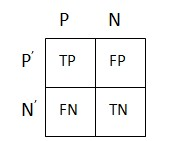在linear model中,我们对各个特征线性组合,得到linear score,然后确定一个threshold,linear score < threshold 判为负类,linear score > threshold 判为正类。画PR曲线时, 我们可以想象threshold 是不断变化的。首先,threshold 特别大,这样木有一个是正类,我们计算出查全率与查准率; 然后 threshold 减小, 只有一个正类,我们计算出查全率与查准率;然后 threshold再减小,有2个正类,我们计算出查全率与查准率;threshold减小一次,多出一个正类,直到所有的类别都被判为正类。 然后以查全率为横坐标,差准率为纵坐标,画出图形即可。
例如,有
| 实际类别 | linear score | threshold 为6 | threshold 为5 | threshold 为4 | threshold 为3 | threshold 为2 | threshold 为1 | |
| + | 5.2 | - | + | + | + | + | + | |
| + | 4.45 | - | - | + | + | + | + | |
| - | 3.5 | - | - | - | + | + | + | |
| - | 2.45 | - | - | - | - | + | + | |
| - | 1.65 | - | - | - | - | - | + | |
| 0/0 | 1 / 1 | 2 / 2 | 2 / 3 | 2 / 4 | 2 / 5 | 查准率 | ||
| 0/2 | 1 / 2 | 2 / 2 | 2/ 2 | 2 / 2 | 2/ 2 | 差全率 | ||
| 0/2 | 1/2 | 2/2 | 2/2 | 2/2 | 2/2 | TPR | ||
| 0/3 | 0/3 | 1/3 | 2/3 | 3/3 | FPR |

行是实际的类,列是分类器得到的类别。常用的术语如下:
真阳性(TP)——正确的肯定
真阴性(TN)——正确的否定
假阳性(FP)——错误的肯定,假报警,第一类错误
假阴性(FN)——错误的否定,未命中,第二类错误
查全率: 预测为正的里面,实际为正的比例。
查准率:预测为正,实际为正 占的比例。
真正例率(TPR) = 查全率
TPR = TP / P = TP / (TP+FN)
假正例率(FPR)
FPR = FP / N = FP / (FP + TN)
PR
1 import matplotlib 2 import numpy as np 3 import matplotlib.pyplot as plt 4 Recall = np.array([0,1/2,2/2,2/2,2/2,2/2]) 5 Precison = np.array([1/1,2/2,2/3,2/4,2/5,0])
Precison = np.array([0,1/1,2/2,2/3,2/4,2/5])
6 plt.figure() 7 plt.ylim(0,1.1) 8 plt.xlabel("Recall") 9 plt.xlim(0,1.1) 10 plt.ylabel("Precison") 11 plt.plot(Recall,Precison) 12 plt.show()

ROC与PR类似,只是横坐标与纵坐标换成成了FPR与TPR,这样FPR与TPR计算时,分母不变,画图更加方便。
绘图过程:给定m1 个正例,m2 个负例. linear score 排序。
在坐标(0,0)标一个点,然后改变阈值,多出一个预测正例,
设当前的坐标为(x,y),当前若为真正例,则对应坐标点的坐标为(x,y+1/m1),当前若为假正例,则对应坐标点的坐标为(x+1/m2,y)
1 import matplotlib 2 import numpy as np 3 import matplotlib.pyplot as plt 4 FPR = np.array([0/3,0/3,0/3,1/3,2/3,3/3]) 5 TPR = np.array([0/2,1/2,2/2,2/2,2/2,2/2]) 6 7 plt.figure() 8 plt.ylim(-0.1,1.5) 9 plt.xlabel("FPR") 10 plt.xlim(-0.1,1.5) 11 plt.ylabel("TPR") 12 plt.plot(FPR,TPR) 13 plt.show()
